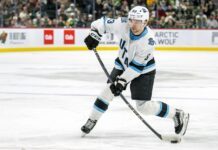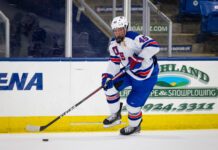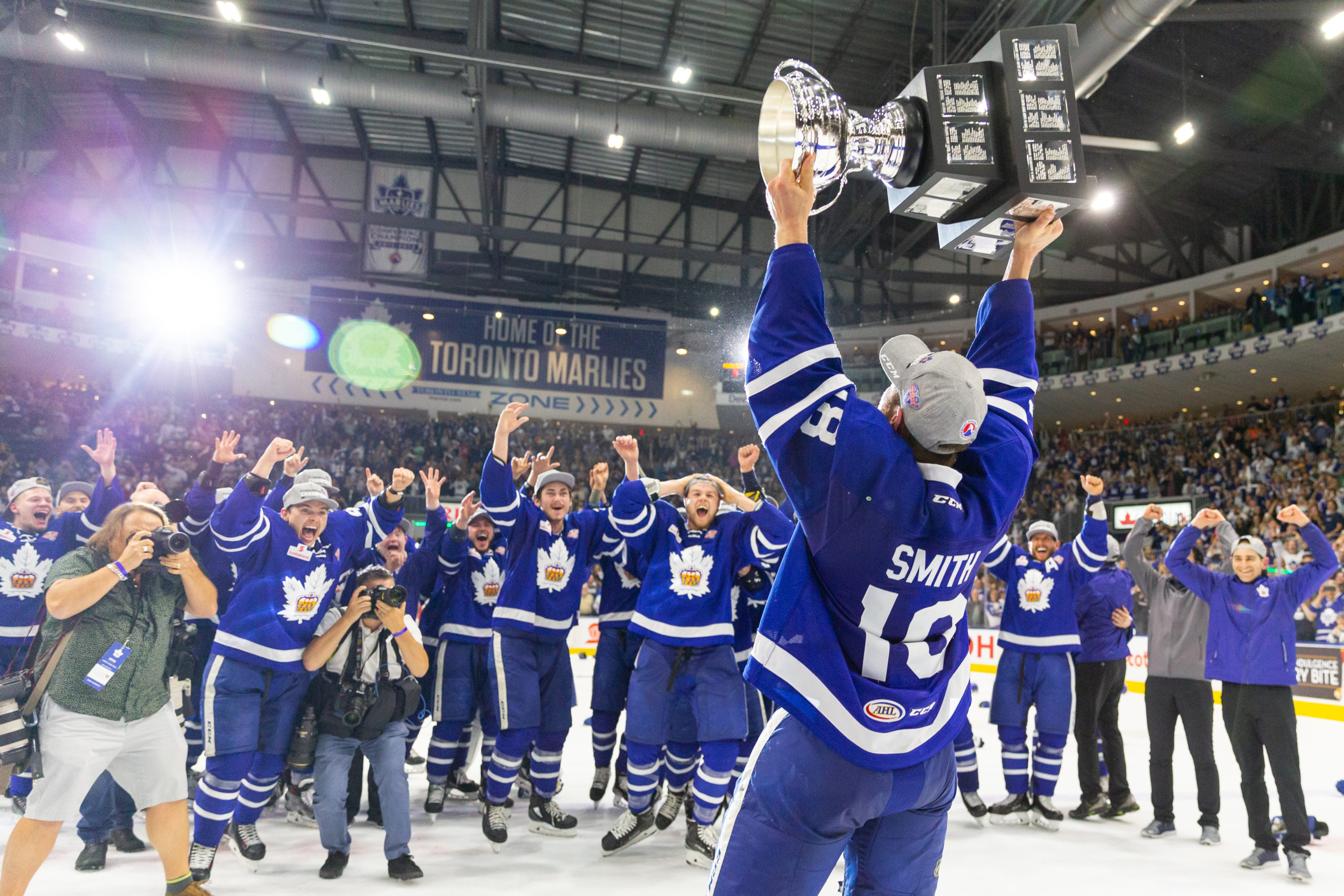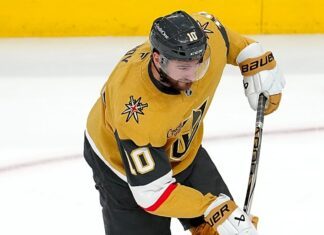An incredible season for the Toronto Marlies ended in a franchise-first Calder Cup championship.
There were many key elements that resulted in a wildly successful 2017-18 campaign, and it’s that time of year to look back at what we learned about the Marlies organization as well as to project what the future may bring.
Proven Prospects & Now-Former Marlies
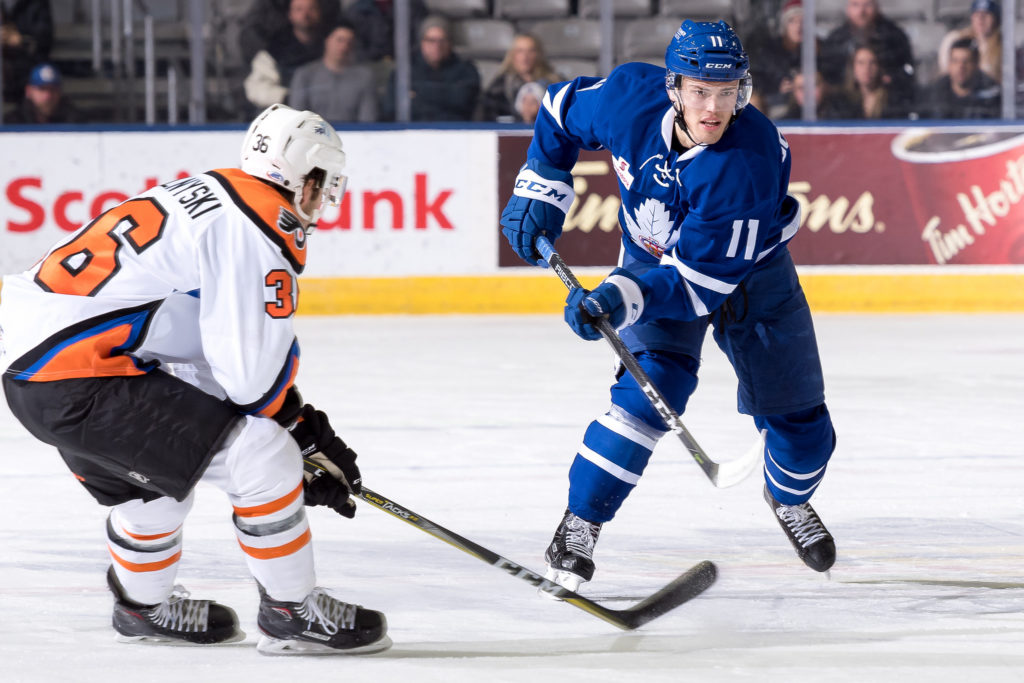
If we didn’t know it before this season, Kasperi Kapanen certainly proved the point by showing yet again that he was too good for the AHL and more than ready for full-time NHL duty.
Kapanen bounced between the two leagues before a full recall in January. By that stage, he had already racked up 24 points (12-12-24) in 28 games and was utterly dominant at the AHL level.
There was no sulking from a young man who knew his opportunity would eventually arrive, and he grabbed it with both hands once the call came. The Marlies staff has rounded the Finnish winger into a versatile two-way forward who is now an excellent asset on the penalty kill and can be used to good effect on the power play. Currently penciled in on the Leafs‘ right wing in behind Mitch Marner, William Nylander and Connor Brown, the 22-year-old could earn his way up in that order and should be in for an expanded role on the penalty kill with the departure of Leo Komarov up front.
AHL All-Star, Calder Cup MVP, and league-leading scorer through the playoffs: It was also quite the season for Andreas Johnsson, who proved himself head and shoulders above the AHL level before going on to open his NHL account against the Montreal Canadiens in a Hockey Night in Canada encounter in March.
The Swedish winger was clinical in front of net and too fleet of foot and quick of mind for American league opponents. In the 16 games before his call-up, Johnsson recorded a staggering 25 points (9-16-25), which included a hat-trick and seven multi-point hauls.
Of his point per game pace through 54 regular season outings, 80% were primary markers, including 26 goals. Johnsson’s game only improved after his relatively short spell in the NHL, as he showcased in his return to the Marlies for the playoff campaign — a further 24 points in 16 games, including a Calder Cup championship, was a fitting end to his time with the Marlies in the American League.
Johnsson, by virtue of being a left winger — where the Leafs are shallower than on the right — could be in for a big rookie year as an over-ripened player who might get some 5v5 opportunities next to high-end centermen throughout the year on what is shaping up to be an elite offensive team. He’s also been a capable penalty killer and a high-end power play option at the AHL level, so he could play a role on either side of special teams.
Travis Dermott transitioned from a fringe NHL player last October to more or less a lock in Mike Babcock’s defensive core in the space of 37 games. The former Erie Otters star defenseman has been on a steep learning curve since impressing as an AHL rookie in 2016-17.
Now 21, Dermott has many impressive traits to his game, including excellent gap control and puck-lugging ability as well as his evasiveness against opposing forechecks. Ally that with the fact that he plays an aggressive, hard-nosed game in which he doesn’t back down from larger opponents, and you can see why he’s won the favour of the Maple Leafs head coach, albeit in managed minutes, particularly in the playoffs.
The only downside to Dermott at the AHL level was his frequent trips to the penalty box as a less-desirable byproduct of his aggressive and proactive approach to playing the position, but it’s something he worked out of his game in the AHL leading up to his promotion, and he was called for just four infractions in 37 NHL regular season games.
His ability to play the right side, at least at the AHL level, could be another added bonus for the organization, as is the way he carries himself on and off the ice. His enthusiasm to win a championship for the Marlies was clear to see in his return to the AHL playoffs, where he and Andreas Johnsson made a huge impact in the crucial round one, winner-takes-all game against Utica and from that point onward.
It was of little surprise that the left-handed shot put up 13 points (1-12-13) during his stint with the Leafs, having tallied 18 points in 28 games with the Marlies to begin the year, and that is certainly one area where we can expect continued growth in his game heading into next season.
Mission number one is earning more of Babcock’s trust through camp and early on in the regular season. Fellow left-shot Calle Rosen came on very strong down the stretch and into the playoffs and will be pushing hard for a job in what should be a highly competitive atmosphere at camp, not to mention Martin Marincin and Andreas Borgman gunning for spots.
Also partly included in this mix of more proven prospects is Carl Grundstrom, who has a couple of years of (productive) pro experience in the SHL and has been an impact player at the AHL level; he tallied three points in two regular-season appearances and added 14 points in 20 playoff games. There were signs throughout the playoffs, however, of his relative inexperience in the North American pro game and a lack of familiarity with the Marlies/Leafs system (he’s also only 20 years old).
While he’ll be pushing for a spot at camp — and he would bring a good mix of skill and jam in a fourth-line role — Grundstrom will likely be asked to prove his dominance at the American league level over an extended regular-season spell with the Marlies first, especially considering the team’s depth up front. The Leafs development approach is one that prefers over-ripe to under-ready.
The benefits of strong veteran leadership
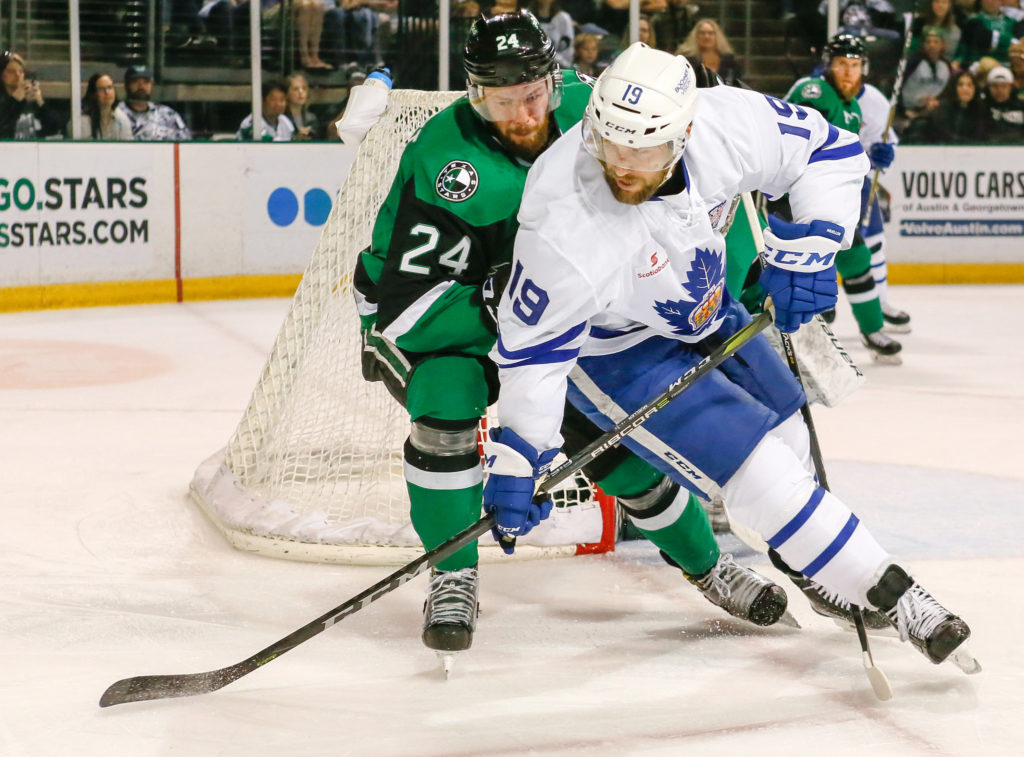
The five veterans on the Marlies 2017-18 roster were a huge part of the team’s success, on and off the ice. All were consistent performers throughout the regular season and their combined experience helped provide the backbone of a championship win, in addition to playing a key role in the development of the Leafs’ prospects.
Ben Smith wasn’t named the captain until mid-way through the season — perhaps hinting at Kyle Dubas’ philosophy on such matters — but his influence can be best summed up by the level of respect every player, young and old, in the locker room has for him.
The 29-year-old drove play for Toronto at even strength and ended with 45 points (73 games) at 5v5, good for fourth in the entire AHL. The Marlies will miss his inspired leadership, versatility and two-way game as he heads to Germany next season.
Chris Mueller continued to prove himself an elite scorer at the AHL level in his first season with the Marlies. Toronto’s power play struggled for parts of the year, but much of its success was driven by the New York native, who recorded 25 man-advantage points to lead the team through the regular season.
That carried over into the postseason, where Mueller once more led the Marlies in power play points, netted a vital overtime winner against Utica in round one, and finished fourth in overall in team scoring. Sophomore Dmytro Timashov certainly benefited from playing alongside Mueller and Smith in the post-season, thriving on the opportunity with 12 points in 20 games.
A consummate professional, Colin Greening knuckled down following a below-par 2016-17 campaign by his standards and gave everything for the Marlies despite facing the reality that his NHL career appears, at this point, to be in the rearview mirror. The Newfoundland native was undoubtedly one of Toronto’s unheralded heroes through the playoffs, and he was a solid performer night after night throughout the whole season. Whoever his linemates were, Sheldon Keefe deployed him to shut down opposing top lines throughout the season and playoffs.
That makes the offensive output a bonus, as the versatile forward finished the regular season with 16 goals to his name (fifth on Marlies) — an AHL career season high for the 31-year-old. Greening is now a candidate to take over the captaincy from Smith, having worn the ‘A’ and committed to a one-year AHL contract for 2018-19.
Toronto’s defense was excellent all season long and a significant part of that was thanks to Vincent LoVerde. The former captain of the L.A Kings affiliate for three years imparted his extensive experience to good effect as part of the veteran leadership core. Playing the right side, LoVerde is the epitome of hockey’s defenseman clichés — solid, dependable, and no-nonsense.
Much stronger than his build might suggest, LoVerde is effective at clearing the crease in front of him and he’s certainly no slouch in possession, adapting successfully to the Marlies system over the course of the year. After struggling for offense early in the year, LoVerde finished with a team-leading nine goals from the blue line despite only scoring once in the first four months.
Along with Chris Mueller, LoVerde was signed to a two-year contract and both deals look like very wise moves at this point.
Rich Clune, meanwhile, loves being in Toronto and all those associated with the Marlies love having him around. Clune was limited to 47 appearances through the regular season and didn’t dress during the playoffs, but his contributions throughout the year were as important as anyone else’s on the roster.
The 31-year-old’s effervescent personality and commitment to hard work is a driving force in the locker room, especially for the younger guys in the dressing room who without fail immediately flock toward his easy-to-like, charismatic personality. Undeniably, Clune brings those intangibles to the locker room that are difficult to put a price on and he will hold every player staying in Toronto this summer accountable for their off-season work habits. His impending return next season is an important as any other signing the organization may make between now and October.
The hole left by Ben Smith may be filled by one or two veteran free-agent forwards signed by Kyle Dubas on July 1.
Adam Cracknell is a highly versatile and experienced forward with over 800 professional games to his name. Over half of those have been accumulated in the NHL, so it was of no surprise that the 32-year-old was one of the lone standouts for Laval Rocket last season despite their abysmal record. His 48 points total in 54 games included a career-high 27 goals.
The second option is Josh Jooris, who is less experienced, having only turned professional in 2013. The soon to be 28 year old (birthday is July 14) is well traveled, having been a part of five organizations, and he has over 200 NHL games under his belt. His lack of offensive numbers may be skewed by opportunities down the lineup in the NHL and his lone full season in the AHL was his rookie year, when he recorded 27 points (11-16-27) in 73 games for the Abbotsford Heat. Like Cracknell, Jooris is also capable of playing down the middle as well as on the wing.
In making the decision to sign both players, there was no doubt some weight put on their character and leadership abilities and how they would fit into the Marlies dynamic.
Emerging Prospects
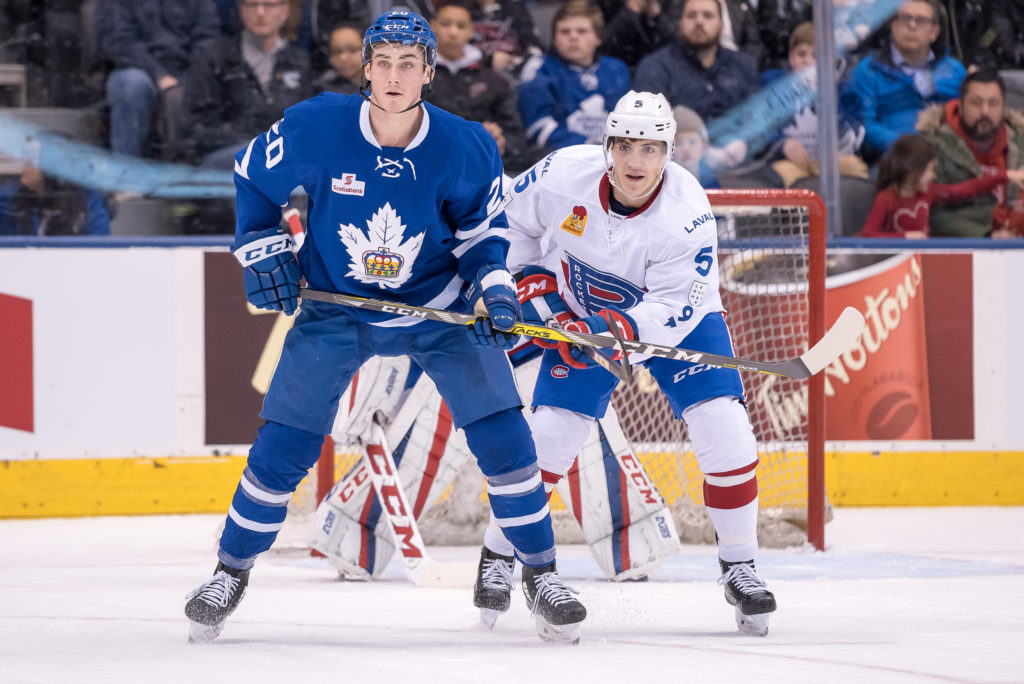
As Kyle Dubas put it in an interview on July 5, the Marlies 2017-18 roster had a group of five high-end veterans leading the way and yet a very young team otherwise.
“We had an interesting mix; we had five really top-end veterans and then nothing really in between. Every game we played, we had the most entry-level players of any team throughout the year in our lineup and particularly in the playoffs. The veterans did an excellent job of bringing those younger players along.”
A few of those youngsters are expected to challenge in Leafs training camp this year, but many — if not all — will return and be asked to take on more responsibility with the Marlies.
Among them, Trevor Moore has forced himself into the conversation looking ahead to 2018 training camp following a really strong second half of the 2017-18 season.
Moore was largely buried down the lineup during his rookie year, only really flourishing when given an opportunity to skate on a line with former Marlie Seth Griffith. Again during the first half of his sophomore season, Moore was struggling to make an impact offensively until something clicked for him in January. The California native went on to produce seven goals and 19 assists during his final 34 appearances and carried that momentum over into the postseason.
With 17 points through 20 playoff games, Moore finished second behind Andreas Johnsson in Toronto’s Calder Cup campaign. The 23-year-old left winger looks to have forced himself into the Leafs conversation come September time; while he’s in tough to crack the roster with the numbers game he’s facing, Mike Babcock should be a fan of his work-rate — he’s possibly the hardest worker on the Marlies — his unwillingness to give up on a backcheck, and his ability to push the pace with the puck on his stick.
The underrated part of Moore’s game is his ability to create scoring chances in various ways — not just off the rush — despite his slight stature. The winger is elusive along the boards and deceptive behind the net, where he can beat opponents and create space with just a couple of strides.
Mason Marchment may have been an AHL rookie coming into the past season, but this was essentially his second year as a professional. Toronto’s commitment to development certainly paid dividends for him — he had a standout campaign despite missing a chunk of the regular season due to a concussion sustained in a fight in Belleville.
His strength and ability to win battles along the wall is expected for someone of Marchment’s build (6’4”/204lbs), but it was the much-improved skating and puck skills that really caught the eye as he racked up 11 points (5-6-11) in the opening nine games of the season.
The Uxbridge native put up 10 points (1-9-10) on the power play as Sheldon Keefe mixed it up on special teams at times throughout the year, but it was on the ’kid’ fourth line at even strength where Marchment was most impressive. Alongside Brooks and Moore/Bracco, especially in the playoffs, Marchment was a handful throughout as the Marlies exploited matchups against every opponent with that trio.
As in the case of Trevor Moore, Marchment has earned himself some consideration for a fourth line job come Maple Leafs camp and does offer an element not present on the wings of the big club, particularly with the big body of James van Riemsdyk now in Philadelphia.
The same would apply to Pierre Engvall, who made an immediate impact after joining the Marlies from the SHL at the tail end of the regular season and into the playoffs. His size, powerful skating stride, and high-end release make him an intriguing prospect, and he responded well to Sheldon Keefe’s coaching after he was asked to play more of an inside game between the dots. Engvall could turn a few heads at Leafs training camp, although with his limited North American experience, the most likely scenario is that he’s counted on as a scoring and power play option with the Marlies to start the year.
Adam Brooks is further behind the aforementioned prospects developmentally, but that’s of no surprise with 2017-18 being his first professional season and his reputation as a slow-burner in his junior career. The Winnipeg native was eased into his rookie year with as much emphasis placed on ice time as hours spent in the gym and with the skills development staff.
Brooks finished the regular season with a flourish offensively, recording 12 points (5-7-12) through his final 13 appearances. He’s going to be a late bloomer as far as the Leafs concerned, but after the signings made on July 1, time isn’t going to be an issue for the player or the club. That said, more will be expected of Brooks going forward as he will be likely be given greater ice time and opportunities in his sophomore season.
Jeremy Bracco’s season took on a similar pattern to that of Adams Brooks, with caution and development the name of the game after he battled mono early on. The right winger finished the regular season as the Marlies’ hottest player offensively with 15 points (2-13-5) through his final 13 games and went on to score Toronto’s first goal of the playoffs.
Unfortunately, Bracco fell victim to the numbers game in the postseason due to the additions of Pierre Engvall, Carl Grundstrom and the returning Andreas Johnsson. Expectations will be higher in his second year after finishing with a flourish, and he will be given greater chances to shine, especially on the power play.
Timothy Liljegren’s Progression
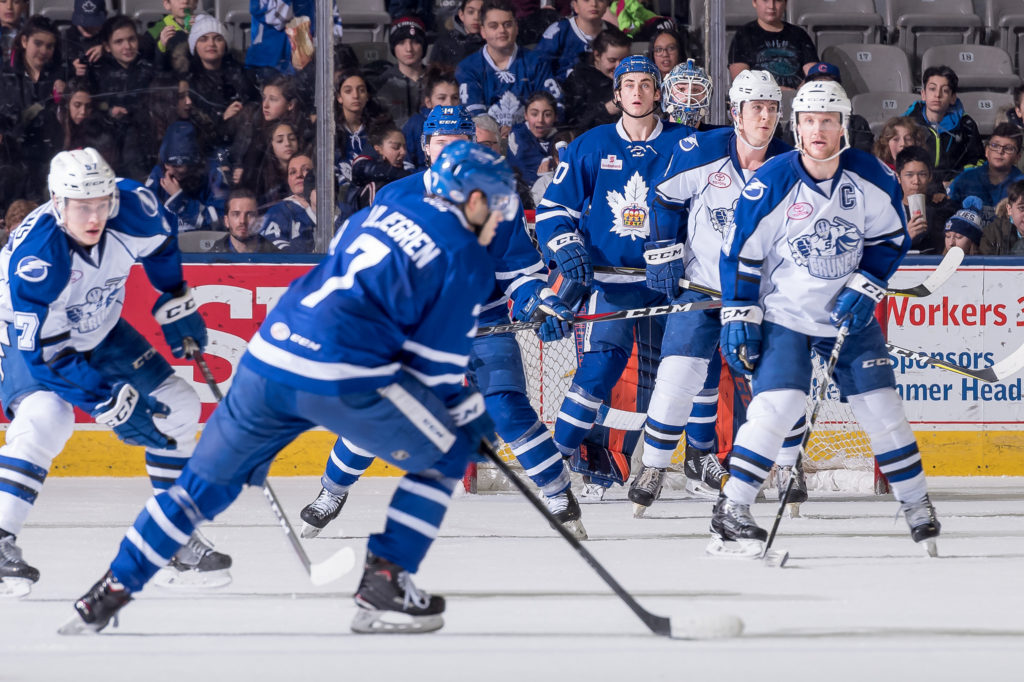
Timothy Liljegren put together a promising AHL rookie season as the youngest blue liner in the league by 16 months and ended the year with the highest points per game for an 18-year-old defenseman in league history.
The Swedish defenseman showed progress throughout the year, which is all you could hope for from such a young prospect in his first professional season. The growth was continuous and steady despite missing a chunk of time in November through injury and a stint away from the AHL to represent Sweden in the World Juniors.
Liljegren began the year looking to carry the puck at every opportunity across three zones in what became lone sorties at times. His turnovers in dangerous spots rarely cost the team because of the Marlies’ excellent goaltending and commitment to team defense, but it highlighted his lack of experience and the fact that he’s not quite the elite skater that many media outlets purported him to be at this stage.
Having been reined in by the coaching staff combined with his willingness to learn and grow, Liljegren’s commitment to the defensive side of his game led to rapid progression in that respect.
He has also been working out to the same degree off the ice, it appears, because he’s now quite strong at his tender age. Not often was he beaten in a physical battle, even when the physical side of the game intensified in the playoffs against veteran opponents nearly twice his age. In fact, Liljegren arguably played his best hockey of the season in the heat of the playoffs, albeit he was given sheltered minutes at times.
Undoubtedly, Liljegren’s vision and puck-moving ability were the aspects of his game that shined all year, with his eye for a breakout through the middle or a long stretch pass down the boards. Combine that with better judgment for when to lead the rush, and Toronto’s ability to transition defense into offense was heightened when the rookie was on the ice.
There is much still to work on, including adding another gear to his skating and developing his shot, but there is much to be hopeful for and look forward to from Liljegren in 2018-19. He should take on an expanded role and be trusted in more important situations.
Sheldon Keefe: Back For Now
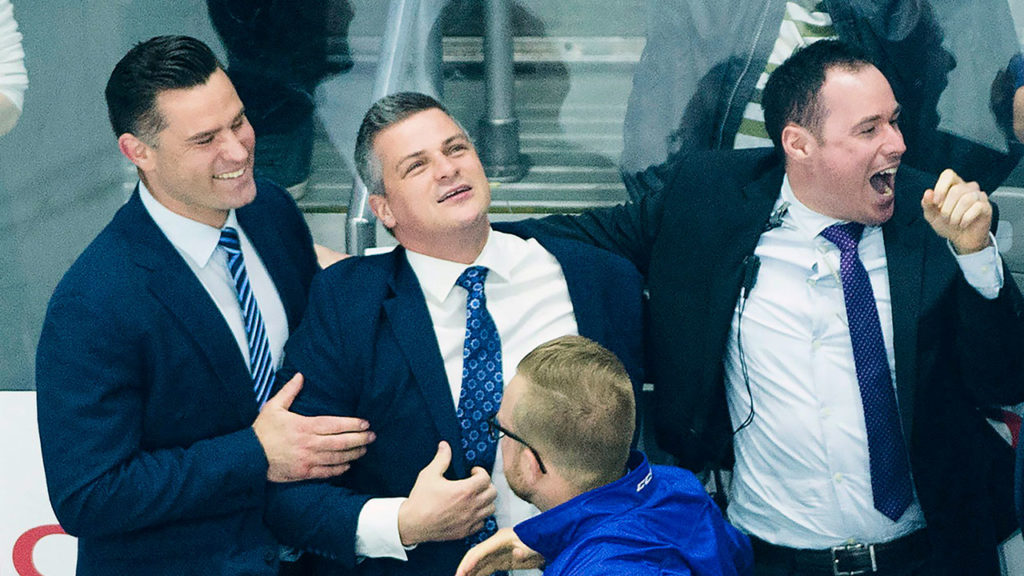
Sheldon Keefe accomplished what no other Toronto Marlies coach before him had been able to by winning a Calder Cup championship.
During the regular season, Toronto matched the franchise record for wins (54), set a new AHL benchmark for road victories (30) and various players set new personal and team bests under his leadership.
It’s more than impressive numbers for the former Sault Ste. Marie Greyhound, however — he has overseen the successful development and transition into the NHL for many young players, which is the main part of his job description.
Andreas Johnsson, Travis Dermott, and Kasperi Kapanen were the latest to make the grade under Keefe’s guidance this season, following on from the likes of William Nylander, Zach Hyman and Connor Brown in previous years. In 2017-18, Keefe oversaw the progression of rookies Timothy Liljegren, Adam Brooks, Mason Marchment, Jeremy Bracco and Trevor Moore in his second year.
It’s not just the youngsters who have developed under his tutelage, however, with Martin Marincin, Andreas Borgman and Calle Rosen three more established players with pro experience who have shown marked improvement in their respective games. And then there is Justin Holl, who has fought his way to this stage from the ECHL and now looks to have an excellent opportunity to make the Leafs roster at camp, having also impressed in a short NHL stint.
Keefe’s future appears to be in Toronto for the time being, with no NHL organization willing to offer him an opportunity to progress up the ladder just yet. That may well change at some point throughout the 2018-19 season, however, and nobody can deny he deserves the chance to test himself at the highest level.
Keefe’s regular-season record since joining the Marlies is a staggering 150-63-15 — a winning and points percentage of 65% and 69%, respectively. Ally that with a strong postseason record of 29-17 and a Calder Cup win to boot, and it won’t be long until the Leafs are fielding calls regarding the availability of their affiliate’s head coach.
The Maple Leafs want to be a talent-producing factory of up and coming players, coaches and management personnel alike, and the unfortunate reality about the NHL head coaching position is that there is only one of them per organization. In the Leafs’ case, they’ve got a winning head coach with a championship track record and the clout of an eight-year contract — one which Mike Babcock has stated he intends on extending by a few more years after the success he’s anticipating over the next five years.
The Transition in the Front Office: From Kyle Dubas to Laurence Gilman

Kyle Dubas shed tears after Mason Marchment scored the final goal of the season in Game 7 of the Calder Cup Finals, overcome by the emotion of seeing his vision for the Toronto Marlies realized after four years in charge. After hoisting the Calder Cup on the ice minutes later in a celebratory outburst that is now the stuff of legend, Dubas has handed over the GM reigns over to his hired replacement, Laurence Gilman.
It’s a big ask for the Vancouver native to continue that same level of success from the farm club, but much of the groundwork has already been laid with the staff, facilities and winning culture in place.
Perhaps the most important task at the beginning of his tenure is to help build the organization’s brand new ECHL affiliate in the shape of the Newfoundland Growlers. There’s a relationship to build with Head Coach Ryane Clowe and his staff, and immediate assignments include assembling a roster that is capable of competing in the ECHL while integrating prospects.
As far as the Marlies are concerned, Colin Greening has already been convinced to stay and has signed a one-year AHL contract, and Rich Clune has confirmed he will also be in Toronto next season, although he is yet to put pen to paper.
In addition to replacing departing captain Ben Smith, Gilman will need to fill other holes on the roster, depending on what the Marlies organization decides to do via trades and signings between now and October.
Sheldon Keefe and Kyle Dubas had what could only be described as an exceptional working relationship, which will be important for Gilman to replicate, and perhaps that is the greatest challenge for him to master in the upcoming season. With NHL teams already taking a look at Keefe’s impressive resume, it’ll be a case of the new GM ensuring the man behind the bench is happy while keeping an eye on a future replacement should the Marlies head coach be prised away in the near future.


